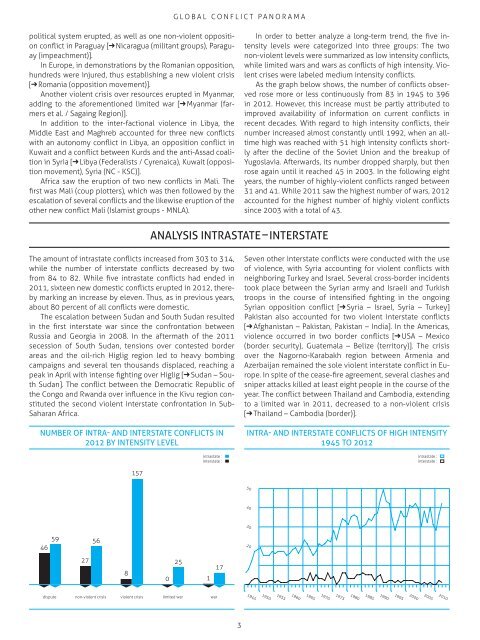ConflictBarometer_2012
ConflictBarometer_2012
ConflictBarometer_2012
Create successful ePaper yourself
Turn your PDF publications into a flip-book with our unique Google optimized e-Paper software.
Global Conflict Panorama<br />
political system erupted, as well as one non-violent opposition<br />
conflict in Paraguay [1 Nicaragua (militant groups), Paraguay<br />
(impeachment)].<br />
In Europe, in demonstrations by the Romanian opposition,<br />
hundreds were injured, thus establishing a new violent crisis<br />
[1 Romania (opposition movement)].<br />
Another violent crisis over resources erupted in Myanmar,<br />
adding to the aforementioned limited war [1 Myanmar (farmers<br />
et al. / Sagaing Region)].<br />
In addition to the inter-factional violence in Libya, the<br />
Middle East and Maghreb accounted for three new conflicts<br />
with an autonomy conflict in Libya, an opposition conflict in<br />
Kuwait and a conflict between Kurds and the anti-Assad coalition<br />
in Syria [1 Libya (Federalists / Cyrenaica), Kuwait (opposition<br />
movement), Syria (NC - KSC)].<br />
Africa saw the eruption of two new conflicts in Mali. The<br />
first was Mali (coup plotters), which was then followed by the<br />
escalation of several conflicts and the likewise eruption of the<br />
other new conflict Mali (Islamist groups - MNLA).<br />
In order to better analyze a long-term trend, the five intensity<br />
levels were categorized into three groups: The two<br />
non-violent levels were summarized as low intensity conflicts,<br />
while limited wars and wars as conflicts of high intensity. Violent<br />
crises were labeled medium intensity conflicts.<br />
As the graph below shows, the number of conflicts observed<br />
rose more or less continuously from 83 in 1945 to 396<br />
in <strong>2012</strong>. However, this increase must be partly attributed to<br />
improved availability of information on current conflicts in<br />
recent decades. With regard to high intensity conflicts, their<br />
number increased almost constantly until 1992, when an alltime<br />
high was reached with 51 high intensity conflicts shortly<br />
after the decline of the Soviet Union and the breakup of<br />
Yugoslavia. Afterwards, its number dropped sharply, but then<br />
rose again until it reached 45 in 2003. In the following eight<br />
years, the number of highly-violent conflicts ranged between<br />
31 and 41. While 2011 saw the highest number of wars, <strong>2012</strong><br />
accounted for the highest number of highly violent conflicts<br />
since 2003 with a total of 43.<br />
Analysis intrastate – interstate<br />
The amount of intrastate conflicts increased from 303 to 314,<br />
while the number of interstate conflicts decreased by two<br />
from 84 to 82. While five intrastate conflicts had ended in<br />
2011, sixteen new domestic conflicts erupted in <strong>2012</strong>, thereby<br />
marking an increase by eleven. Thus, as in previous years,<br />
about 80 percent of all conflicts were domestic.<br />
The escalation between Sudan and South Sudan resulted<br />
in the first interstate war since the confrontation between<br />
Russia and Georgia in 2008. In the aftermath of the 2011<br />
secession of South Sudan, tensions over contested border<br />
areas and the oil-rich Higlig region led to heavy bombing<br />
campaigns and several ten thousands displaced, reaching a<br />
peak in April with intense fighting over Higlig [1 Sudan – South<br />
Sudan]. The conflict between the Democratic Republic of<br />
the Congo and Rwanda over influence in the Kivu region constituted<br />
the second violent interstate confrontation in Sub-<br />
Saharan Africa.<br />
Number of Intra- and Interstate Conflicts in<br />
<strong>2012</strong> by Intensity Level<br />
intrastate :<br />
interstate :<br />
Seven other interstate conflicts were conducted with the use<br />
of violence, with Syria accounting for violent conflicts with<br />
neighboring Turkey and Israel. Several cross-border incidents<br />
took place between the Syrian army and Israeli and Turkish<br />
troops in the course of intensified fighting in the ongoing<br />
Syrian opposition conflict [1 Syria – Israel, Syria – Turkey]<br />
Pakistan also accounted for two violent interstate conflicts<br />
[1 Afghanistan – Pakistan, Pakistan – India]. In the Americas,<br />
violence occurred in two border conflicts [1 USA – Mexico<br />
(border security), Guatemala – Belize (territory)]. The crisis<br />
over the Nagorno-Karabakh region between Armenia and<br />
Azerbaijan remained the sole violent interstate conflict in Europe.<br />
In spite of the cease-fire agreement, several clashes and<br />
sniper attacks killed at least eight people in the course of the<br />
year. The conflict between Thailand and Cambodia, extending<br />
to a limited war in 2011, decreased to a non-violent crisis<br />
[1 Thailand – Cambodia (border)].<br />
Intra- and Interstate Conflicts of high Intensity<br />
1945 to <strong>2012</strong><br />
intrastate :<br />
interstate :<br />
157<br />
50<br />
40<br />
30<br />
46<br />
59<br />
56<br />
20<br />
27<br />
8<br />
0<br />
25<br />
1<br />
17<br />
dispute non-violent crisis violent crisis limited war war<br />
1945<br />
1950<br />
1955<br />
1960<br />
1965<br />
1970<br />
1975<br />
1980<br />
1985<br />
1990<br />
1995<br />
2000<br />
2010<br />
2005<br />
3


